Play review of the deck-building game 'Looking for El Dorado', which seeks out the golden town that has not been seen yet, overcoming the river through the jungle.

On June 25, 2020, Arclight Games released a new version of the deck-building sugoroku board game ' Looking for Eldorado ' in full Japanese. It is a game designed by world-famous board game writer
Looking for Eldorado New Edition Full Japanese Edition | ArclightGames Official
https://arclightgames.jp/product/%E3%82%A8%E3%83%AB%E3%83%89%E3%83%A9%E3%83%89%E3%82%92%E6%8E % A2% E3% 81% 97% E3% 81% A6% E6% 96% B0% E7% 89% 88 /
The 'Looking for El Dorado' package depicts the golden El Dorado across the canyon. The number of players is 2 to 4, the play time is 45 minutes, and the target age is assumed to be 10 years or older.

The contents are rule manuals and tiles used in the game.

Player board and card. A promo card is included in this full Japanese version.

There are two four-color expedition pieces each, which represent the silhouette of an explorer.

The game has a simple rule that 'the person who reaches El Dorado earlier than anyone else wins'. Players take the expedition to overcome jungles, ponds, and indigenous settlements ...

Aim for the golden city of El Dorado, located on the edge of the tile.

Connect terrain tiles made up of hexagonal squares to form a game board. You can connect the tiles freely. This time, it was the configuration for the tutorial written in the manual at the beginning, and it was played by 4 people.

Before starting the game, list 18 types of market cards used in the game. Place 6 types of market cards with the sun mark on the bottom right of the market board.

Then, arrange the remaining 12 types on the market board.

Players will be given an expedition piece, a player board, and eight starting expedition cards. At the bottom right of the eight starting exploration cards, the same jewels as those on the player board are drawn.

The starting exploration card is often shuffled and placed on the left side of the player board. Then draw 4 cards from the deck.

The start player will receive a start player marker designed with a lizard with a grain of gold dust on the brim of

Clockwise from the start player, the expedition pieces are placed in order on the number squares at the start point of the departure point tile. Now you are ready to go.

The player's turn processes the three phases of 'playing the hand', 'discarding the played card', and 'replenishing up to 4 cards' in order.
'Play hand' proceeds by processing 'moving expedition pieces' and 'purchasing cards' in order. Green, blue, and yellow icons and numbers are drawn on the cards, and players can advance the expedition pieces according to the numbers on the cards they have issued. For example, if you put out one 'Expedition' card with a green 1 and one 'Sailor' card with a blue 1 in the field ...

You can go one square in the 'jungle' and then one square in the 'river' as shown below. Since it is important to 'issue one card at a time', the course of the expedition team will change depending on the order in which the cards are issued.

If it's a 'Take Point' card with a green 2 written on it ...

You can go 2 squares in the jungle as follows. In addition, icons such as Nata in the jungle and oars in the river are drawn. Some of them have multiple icons drawn on them, and you need a card with more numbers than the number of icons to enter. In the following case, the second route from the left is a jungle with two Nata drawn, so it was possible to enter because it was a repulsion of 'Green 2', but it is not possible to enter with two adventurers of 'Green 1'. can not.

In addition, 'obstacle tiles' are installed between the terrain tiles. Obstacle tiles are placed inside out and you must turn the obstruction tiles upside down and pay the costs stated there to advance to the next terrain tile. For example, you need to pay one coin to remove the following obstacle tiles.

The first player to pass will pay the cost and keep the removed obstacle tiles at hand. If multiple adventurers score in the same number of turns, the player with the most obstacle tiles wins, so if the competition is barely enough, 'how many obstacle tiles have been removed' will determine the outcome. It will be.
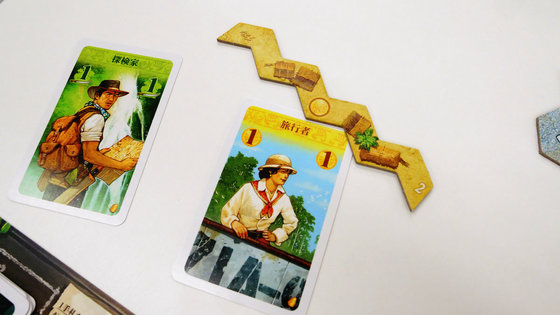
'Purchase Market Cards' allows you to purchase only one card from the market cards lined up. However, you cannot freely choose from 18 types of cards that can be purchased, only 6 types placed on the market board.
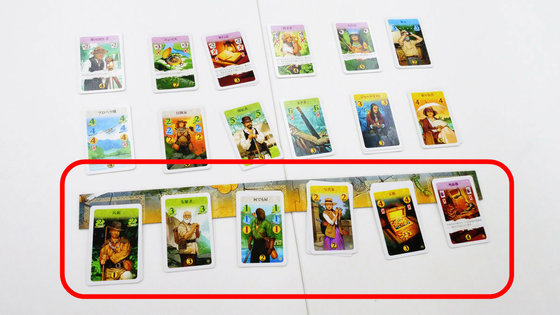
When you buy a card, you pay for it with a gold coin icon and numbers. For example, by paying two 'Traveler' cards with a gold 1 drawn on them ...
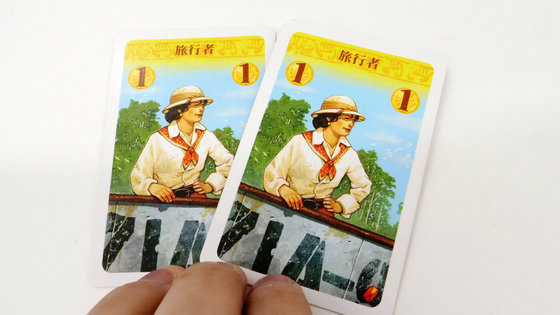
You can buy an 'Anything Shop' card that can be purchased with two gold coins. The Anything Shop is a card with a green, blue, and gold 1 drawn on it, and you can choose which color to use when using it.

There are 3 cards for each type. If the third card is purchased and the market board becomes empty, the next person to buy the card can choose one of the 12 types above as well as the 5 types remaining on the market board.
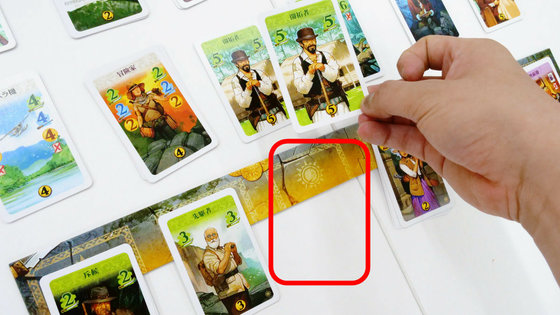
If you choose and purchase one card from 12 types, a pile of that card will be placed in an empty space on the market board. In other words, the market card placed on top cannot be purchased unless there is space on the market board. One of the points is that the card you want does not always enter the market board because you do not always come around to yourself with the market board empty.
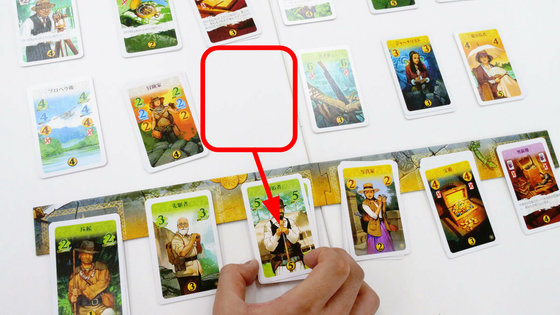
There are 3 different types of market cards, so as the game progresses, the pile of cards will disappear in a blink of an eye.
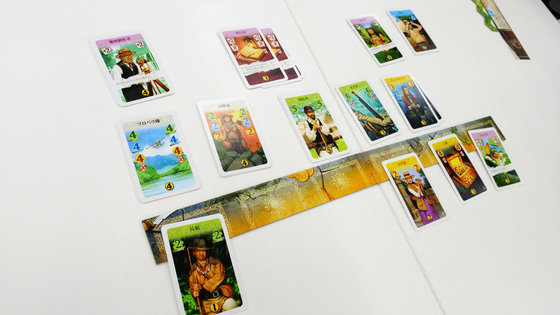
The red square that the red expedition piece entered is a 'camp' that you can enter by discarding the cards from the deck.
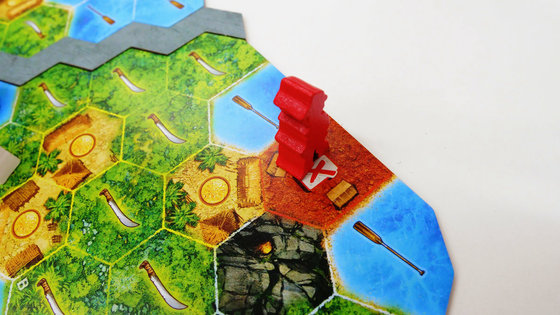
When you buy cards, the number of cards in your deck will increase steadily, and the probability of drawing the card you want to use will inevitably decrease. Therefore, it is important to 'compress' to make it easier to draw the desired card by discarding unnecessary cards from the deck. The red player, who started the strategy of compressing the deck from the beginning, discarded the captain's card with the blue one.

However, the yellow expedition advanced the piece next to it. Expeditionary pieces cannot be advanced or overtaken in squares with other expeditionary pieces. Also, it is impossible to advance the frame to the black mountain trout. You can escape from the river trout in front and behind, but the red expedition has been unable to move forward because the captain's card was discarded shortly before. Obstructing the opponent's course like this is one of the important strategies in this game.
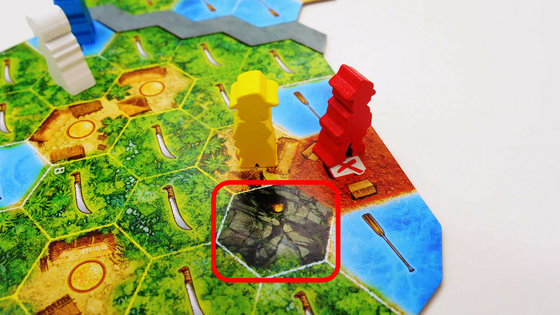
The expedition team that advances the game like that and reaches the final goal tile wins. In the first play, I proceeded while grasping the rules as a tutorial, but it ended in less than an hour with 4 players.
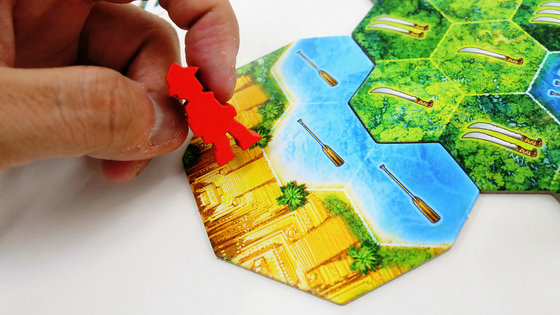
In the rule manual, the difficulty was set by how to connect the terrain tiles. Below is a standard level map called 'Large Meander'. It features a curved structure that looks like a big snake.
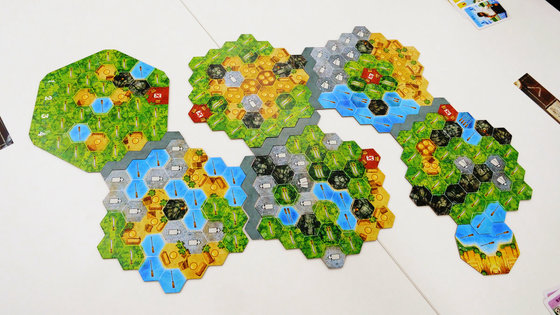
'In the end, the one who finds El Dorado early is the winner,' said the White expedition, carefully choosing the route and moving forward.
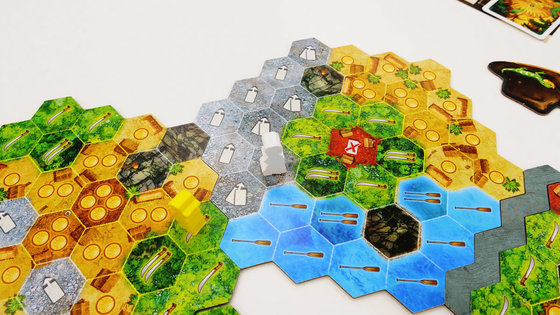
However, the yellow expedition overtook the white expedition by choosing a short distance as if they were attacking the corner of the race circuit from the inn, and a dead heat unfolded in the jungle.
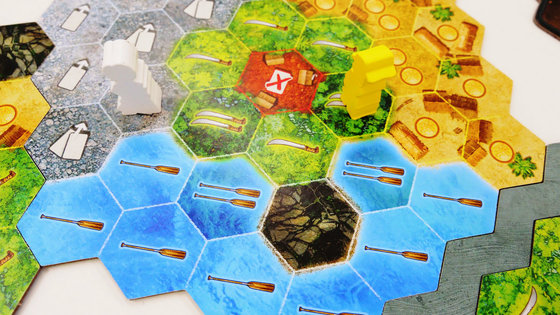
The last terrain tile in front of the goal, the route chosen by the yellow expedition is below. The last terrain tile has to be detoured by the mountain tiles in the way, but the following routes can be shortcuts, but you have to cross the river where all four are required.
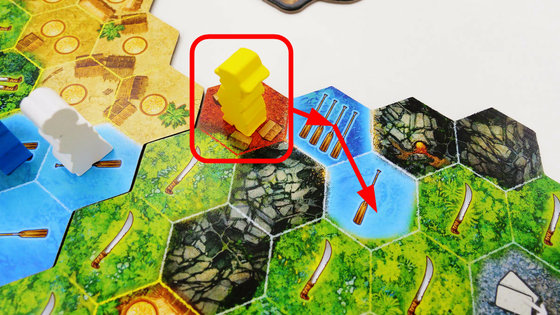
All you need to cross the river is a card called a 'propeller plane'. Although it can only be used once, it is the only market card with a 'blue 4' drawn on it, and it is a must-have card to pass the shortcut. The yellow expedition buys a propeller plane here and builds it into the deck.

The shortcut road was blocked by the yellow expedition, forcing other expeditions to catch up quickly.
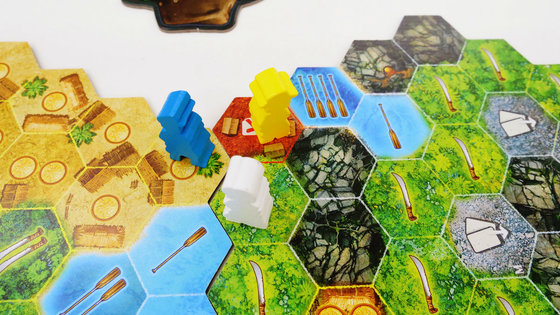
After that, the yellow expedition draws the long-desired propeller plane into their hand and puts it into play, but ...
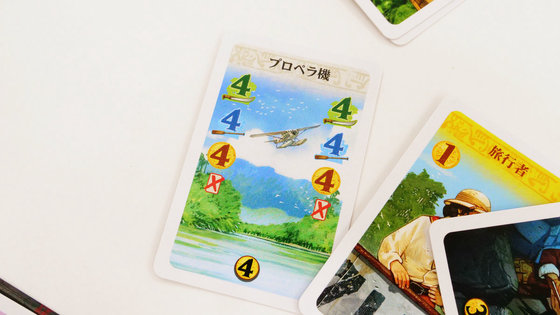
It was necessary to cross the river further beyond the propeller plane. Unfortunately, the Yellow Expedition couldn't draw any more cards to advance the river, so it's stuck here again.
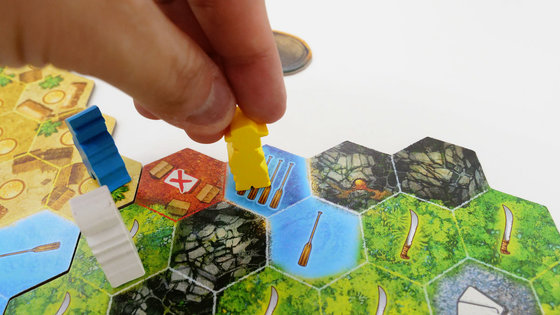
With the yellow expedition struggling to escape by the shortcut, the red expedition steadily advanced the pieces and scored first. It was a development that embodies the saying, 'Hurry up.'
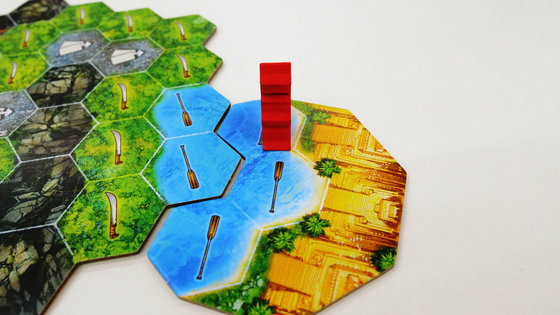
The last map I played was 'Numazawa' for advanced players.
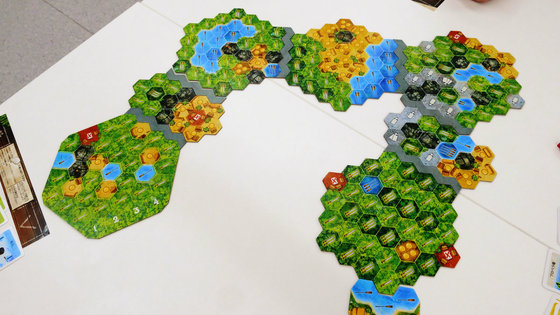
In this map, we adopted the selection rule 'cave'. The following cave tokens are used in the cave rules, and they are shuffled by stirring them inside out.
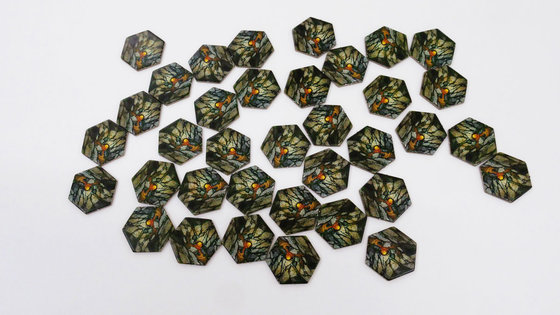
Then divide the cave tokens into 4 pieces and place them on the cave squares on the board. You can draw one cave token by advancing the piece to the square adjacent to the cave square.
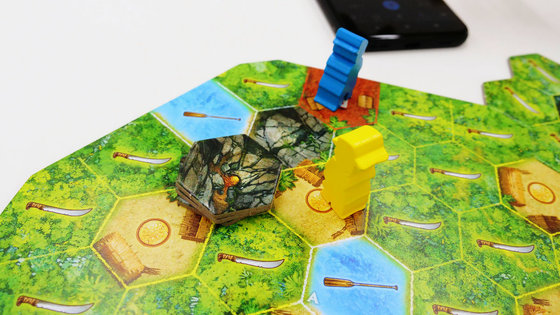
For example, a cave token with the following gold 2 drawn can be used to purchase a card as two gold coins. You can keep the cave tokens you get and use them at any time of your turn, and they will be removed from the game.
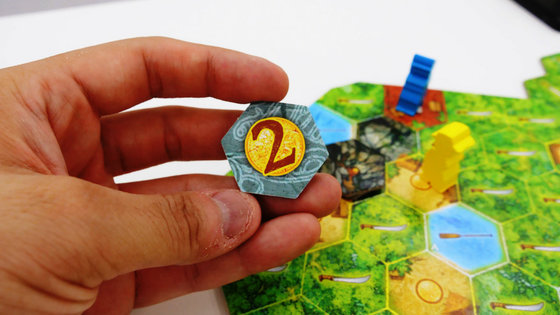
The following scene shows the yellow expedition using a cave token. This cave token has the effect of allowing you to advance pieces to squares with other expeditions.
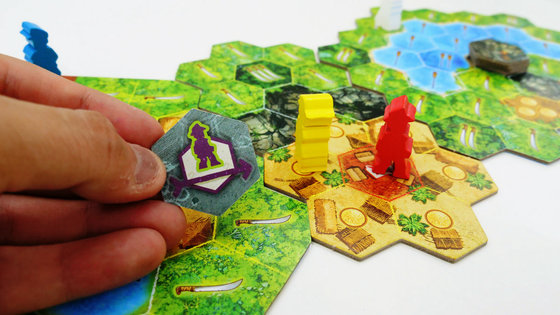
The effect of this token allowed the yellow expedition to advance to the camp with the red expedition. On the other hand, the red expedition team, which was thinking of 'a strategy to compress the deck on a large scale by repeatedly going in and out of the camp', has to withdraw from the camp because the yellow expedition team entered the camp. I couldn't get it, and I couldn't carry out the operation.
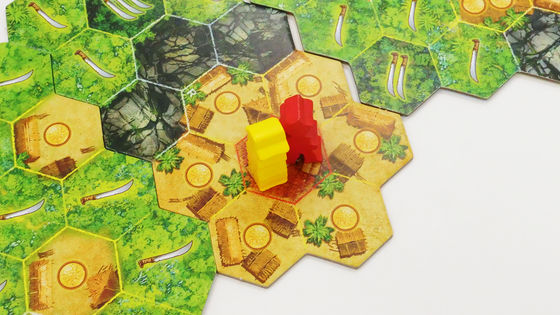
While the white expedition precedes 'speed is everything' and the yellow and red expeditions are fluttering behind it, the blue expedition is far behind, entering the camp many times and meticulously decking. I was doing compression.
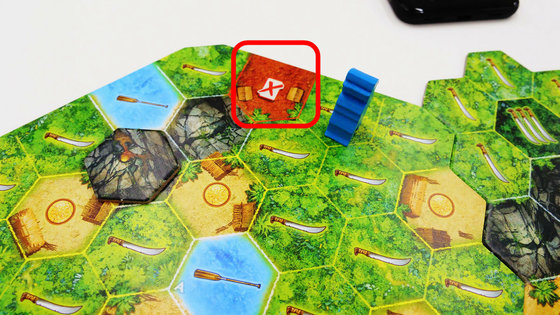
The blue expedition, which has fully compressed the deck, will also start chasing after, but the leading white expedition is quite far away, and the blue player is impatient, saying, 'It may be difficult to recover this distance as expected.' Show you.
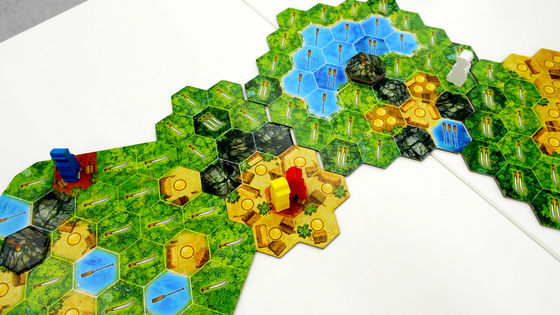
On the other hand, the yellow and red expeditions are stuck in the jungle and steadily cut through the jungle ...
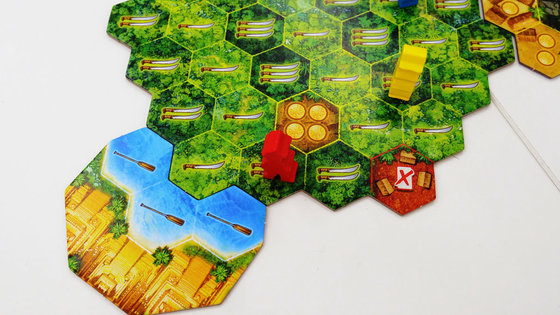
Overtaking the white expedition that was ahead and almost certainly reaching El Dorado on the next turn. The white expedition, who was the starting player, is inevitably defeated if he does not finish this turn. Anyway, in order to hurry ahead, the white expedition set out to advance the jungle at once using the 'Large Nata' card with a green 6 drawn, but the card was badly drawn and eventually El Dorado was in front of me. I'm exhausted.
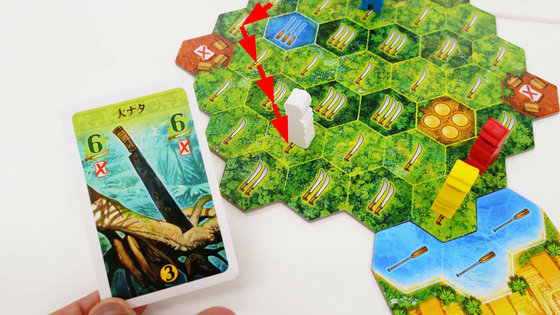
While it seemed like a yellow or red victory, the blue expedition team, which compressed backwards and maximized card efficiency, chased. Cut through jungle-filled terrain tiles with 'pioneers,' 'big nata,' 'everything shop,' and even cave tokens ...
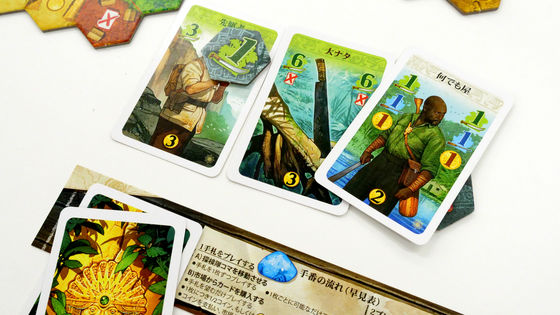
In the development that the blue expedition team will score the goal first.

Yellow and red also arrived at El Dorado on the same turn, but there is no difference as all obstacle panels were acquired by the preceding White expedition. In this case, 'the player with the earliest turn order wins', so it was the victory of the blue expedition team that was catching up at once.

When I actually played 'Looking for El Dorado', the rules were very simple, the effects of the cards were almost non-complex, and I felt that the game was easy to play even for beginners who are not familiar with board games. I did. The development of the game changes greatly depending on the number and combination of terrain tiles, so even those who are familiar with the game can play with a fresh feeling every time.
Like deck-building card games like Dominion , deck-building is a big part of the strategy in Finding El Dorado. Especially when the deck is compressed, the impression that the game development is greatly advantageous. The effect of the cards themselves is simple, but it was a game that asked how to combine them and in what order they would be put into play.
Also, since it is a sugoroku-type racing game, it is a big point of this game not only to think about the composition of the cards but also to think about the part 'what route should be followed'.
'Looking for El Dorado' is available on Amazon.co.jp and can be purchased for 5084 yen including tax at the time of writing the article.
Amazon | Looking for Eldorado New Edition Full Japanese Edition | Board Games | Toys
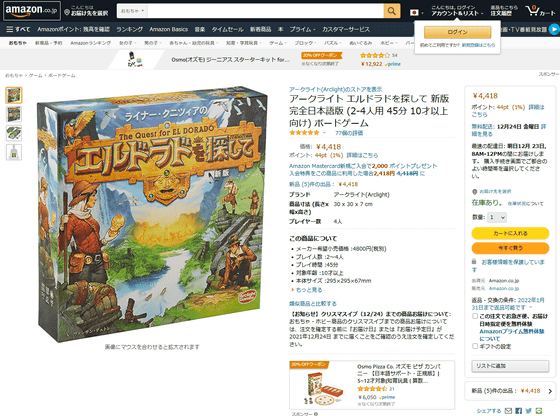
Related Posts:







